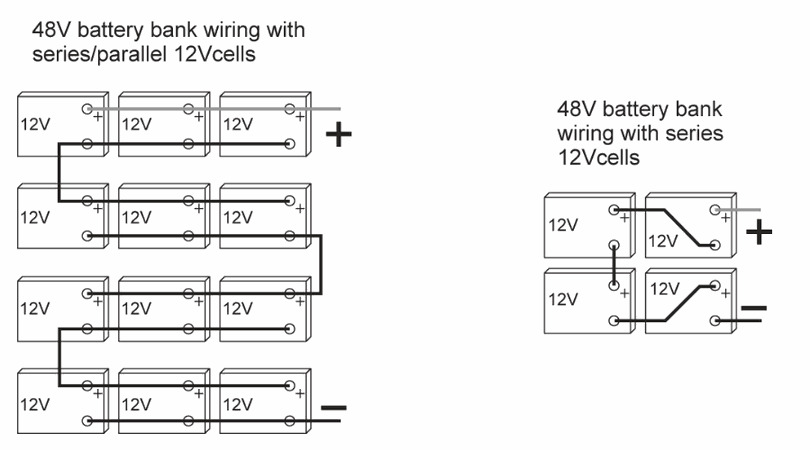Batteries
dimensioning the battery
The battery bank is dimensioned depending on users possibilities and consumption needs. General battery bank designs are explained here.
battery types
Lithium or lead acid. Here you can read about it.
Dimensioning the battery
The battery bank is dimensioned depending on the user's daily energy consumption and the number of days of autonomy required. It is sized also in function of the wanted daily Depth Of Discharge (DOD).
The dimensioning of the battery must also consider the power and the type of loads that are connected to the inverter. As rule of thumb, the maximum power of a lead acid battery is given with the capacity divided by five (C/5), in that case if all the power of the next3 is wanted (16kW), the capacity of the battery should be at least16000*5/48=1666 Ah. For lithium, see the maximum power defined by the manufacturer as lithium batteries are generally rated with a much higher current (C/3 or even 1C).
Take into account the surge power of loads, for example for motor starting and the overload capacity of the inverter to dimension your battery system.
The dimensioning of the battery must also consider the power and the type of loads that are connected to the inverter. As rule of thumb, the maximum power of a lead acid battery is given with the capacity divided by five (C/5), in that case if all the power of the next3 is wanted (16kW), the capacity of the battery should be at least16000*5/48=1666 Ah. For lithium, see the maximum power defined by the manufacturer as lithium batteries are generally rated with a much higher current (C/3 or even 1C).
Take into account the surge power of loads, for example for motor starting and the overload capacity of the inverter to dimension your battery system.
battery bank design
Lead batteries are usually available in 2Vdc, 6Vdc or 12Vdc blocks. To get the correct operating voltage for the next3 (exclusively 48Vdc), several batteries must be connected in series. The capacity of the batteries can be increased using a parallel connection of several battery strings.The various cabling options for the battery are presented in figures below.
Strictly conform to the manufacturer's instructions for parallel connections, especially with lithium batteries.



precautions when using batteries
The batteries should only be chosen, dimensioned, and installed by qualified personnel. Lead- acid batteries with liquid or gelled electrolyte produce a highly explosive gas during normal use. Other special types of batteries present similar risks. Avoid source of sparks or fire in the immediate vicinity of the batteries. The batteries must be kept in a well-ventilated place and installed to avoid accidental short-circuits when connecting. Never try to charge frozen batteries. When working with batteries, a second person is required to give assistance in case of problems.Fresh water and soap must be kept close at hand to allow adequate and immediate washing of the skin or eyes affected by accidental contact with the battery acid. In the event of accidental contact of the eyes with acid, they must be washed carefully with cold water for 15 minutes. Then immediately consult a doctor.
Care is required when working close to the batteries with metal tools. Tools such as screwdrivers, open-ended spanners, etc., may cause short circuits. Sparks created by short- circuits may cause the battery to explode. Therefore, these kinds of tools must always have isolated handles and never be placed on top of a battery. When working with the batteries, all metal jewellery such as rings, watches with a metal bracelet, earrings, etc., must be taken off. The current supplied by the batteries during a short circuit is sufficiently powerful to melt the metal and cause severe burns.
Batteries at the end of their life cycle should be recycled in accordance with directives from the responsible local authorities or the battery supplier. The batteries should never be thrown into fire as they may explode. Under no circumstances should you try to take apart or dismount the battery, as they contain toxic and polluting materials. For ungrounded battery systems, always check that they are not inadvertently grounded before starting to work on the batteries.
Always carefully follow the instructions of the battery manufacturer.